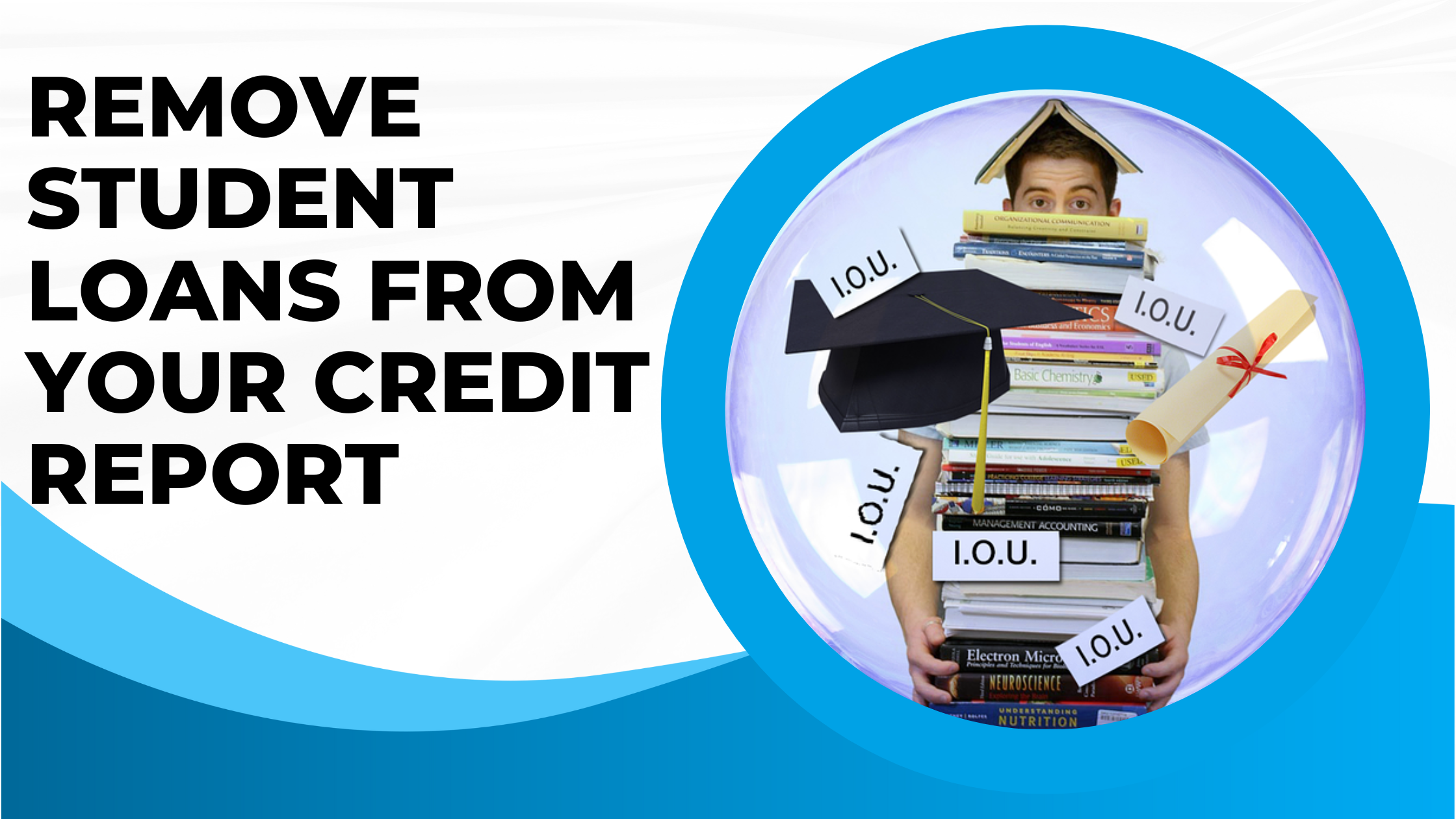If you have been a student and have taken student loans, then you have probably realized what a strain these debts are when trying to get ahead in life.
Can you remove student loans from your credit report?
Short answer: Not easily.
At least not legally.
Student loans are the gifts that keep on giving (and taking). Before you become disheartened, you need to examine this question and answer more closely.
Table of Contents
ToggleThe catastrophe of student loans
Cumulatively, Americans owe more than $1.7 trillion in student loans. This is according to estimates calculated by the Federal Reserve. That number is scary by any measure, and it gets worse when you realize that over 44 million Americans owe student loans.
This means that there’s a good chance that you or someone you know is stressing over their student loan debt right this second.
The worst part is that these student loan debts can wreak havoc on your credit score. Forget about the fact that you will probably spend the rest of your life paying them off. You now have to live with the reality that missing any of these payments could make borrowing near impossible.
Admittedly, student loans are a big part of society, and many students couldn’t afford higher education without them. However, on the flip side, these loans can cripple your financial stability and security if not managed well.
Let’s take a quick look at how you can manage these debts and remove student loans from a credit report.
Can You Remove Student Loans from Your Credit Report?
While it’s true that you can’t legally remove student loans from your credit report, it’s also true that you SHOULDN’T want to remove student loans from your credit report. At least not if your repayments are in good standing.
One of the biggest indicators and factors determining your credit score is your debt repayment or management history. The more you regularly pay down debt on time, the more you appear to be a reliable borrower who can be trusted to make their repayments. The major credit bureaus love seeing this, and they will indicate to potential lenders that you have a good debt repayment history by giving you a good credit score.
So, no, you shouldn’t want to remove student debt from your credit report since it paints your debt management skills in a positive light.
Therefore, the real question should be: How do you remove defaulted student loans from your credit report?
That is a whole different ball game and a matter that you can do something about.
How to Remove Defaulted Student Loans from Your Credit Report
When it comes to removing negative student loan entries from your credit report, the process is almost as complicated (or next to impossible) as actually ending the loan itself. However, it can be done if you go about it in the right way.
How can you remove negative student loans from your credit report?
The best option you have is to write a dispute letter to the major credit rating authorities (TransUnion, Experian, and Equifax). Even though this sounds quite simple, some important factors come into play.
When trying to have a negative student loan entry removed from your credit reports by writing a dispute letter, your chances of success are much higher when dealing with a federal loan than when dealing with a private student loan.
Options Offered By Federal Student Loans
Federal student loans tend to offer you a wider range of options for dealing with disputes and removing negative entries than private loans. Here are some ways that you can have these negative entries removed from your credit report if you have a federal student loan:
- Make consecutive payments: If you are in default of your federal student loan repayments, one way to have that negative report removed is to make at least 9 out of the next 10 repayments on time.
- Make larger repayments: Another way is to take advantage of your income and make larger repayments toward your student loan. Not only does this lower your debt, but it also lowers your debt-to-income ratio even when you are in default.
- Take advantage of the Public Service Loan Forgiveness Program: If, on the other hand, you don’t want to just remove the negative entry but want to do away with your student loan altogether, you can take advantage of the Public Service Loan Forgiveness Program.
This program demands that you serve at least 10 years of employment by a government agency or an approved nonprofit. It also demands that you make timely student loan repayments during that time. Doing so might get the remainder of your student loans forgiven after ten years.
Options Offered By Private Student Loans
The simple truth is that private student loans don’t offer you that many options when it comes to dealing with defaults or late repayments. You could try talking to the lender to adjust your monthly repayments so you don’t fall behind or ask if the credit bureau has some kind of forbearance for a borrower’s tough financial times
Other than that, it’s very unlikely that a private lender will help to remove the negative entry from your credit report.
What Can You Have Removed from Your Student Loan Credit Report?
Since we have already established that it’s impossible to have your student loans removed from your credit report, the next question would be: can you at least make the report more flattering by having any other unfavorable factors removed?
The answer is yes.
There are some negative entries that you can have removed from your credit report concerning your student loan repayments. While these entries will not wipe the slate clean, removing them will at least make your credit score a bit more impressive. Here are some things you can fix:
- You can have a student loan that does not belong to you removed from your credit reports (yes, these kinds of mistakes do happen)
- You can have an erroneous “late repayment entry” removed or corrected
- Any negative entry that is made while your student loan is in forbearance or deferment
- Erroneous default status reports
While it’s true that we live in the age of technology, errors still occur, and it’s not unheard of for clerical mistakes to happen.
You might be the victim of erroneous payment entries or even payment misplacement, resulting in a “default report” being entered into your credit report.
Should any of these mistakes occur, it’s up to you to ensure that they are corrected, which means doing your homework.

Correcting Erroneous Student Loan Entries in Your Credit Report
Here are some steps you need to take to correct any mistaken student loan entries from your credit report:
- Regularly review your credit report: Legally, the three main credit rating agencies are required to offer you a free credit report each year. You should always take advantage of this to review your credit report and audit it for errors.
Should you find an error in your student loan entries, you should immediately determine what that error is and find any documentation or proof to support your claim that the entry is incorrect. - Call your lender or student loan servicer: Once you have all your ducks in a row, you need to contact your student loan servicer and bring the error to their attention. In many cases, it’s usually just a clerical error that can be resolved over the phone. Should that happen, be sure to follow up with email correspondence. This creates a “paper trail” for future reference or additional disputes.
- Write a student loan dispute letter: The most effective method, however, is to write a student loan dispute letter. This letter needs to be convincing and precise. State the error and attach the documentation proving it’s an error.
Should you not hear from the servicer, follow up the letter with another email and phone call after about two weeks.
Once that is done, check your credit report after another 30 days to ensure that the error has been fixed.
How Long Do Student Loans Stay on your Credit Report?
Seven years!
Should you have an unresolved negative report or default on your student loan repayments, that entry will remain in your credit report for seven years.
However, if you have paid your loan in full, it will show as a zero balance. That default report can only be removed by correcting your loan with the methods mentioned above for federal student loans.
Things that Could Happen if You Don’t Remove Student Loans from Your Credit Report
At this point, you might wonder what’s the worst that could happen since there’s no legal way to remove student loans from your credit report?
Here are some issues you’ll have to contend with if you simply refuse to deal with your student loan debt:
- Late fees: You will probably suffer a late fee penalty that could be up to 6% of the loan balance.
- Ruin your credit score: Defaulting on any loan repayment ruins your credit score, making it harder, more expensive, or even impossible for you to get any credit in the future.
- No more loan benefits: In some cases, federal student loans, as well as private student loan lenders, can offer you deferments or forbearance if you fall into tough financial times.
Unfortunately, these options are not available to people with a default on their credit report. - Wage garnishment: In the most extreme of cases, you could have your wages garnished to forcefully make you pay back your student loans. These wage garnishments could amount to 25% of your entire paycheck!
- No tax refunds: In some cases, the government might withhold your tax refunds to pay for your student loans when dealing with federal student loans.
- Cosigners might be forced to pay: If you had a cosigner for a private student loan, they might be forced to make the repayments on your behalf.

Making timely payments is the best recourse for dealing with student loans on your credit report. If you are struggling, you can always talk to your lender to see if they can agree to smaller repayments, but no matter what you do, always make the payments.

